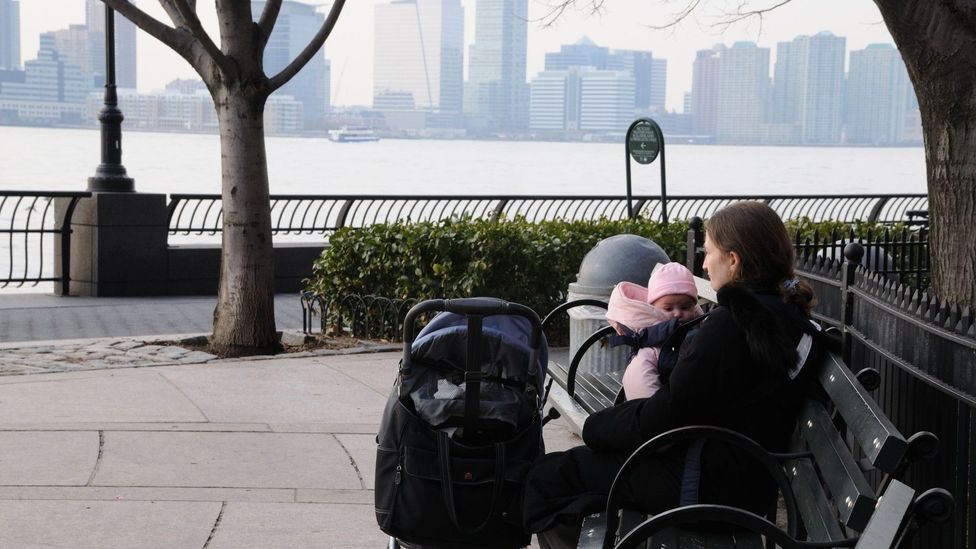The rich nation without maternity leave

Why doesn't the US have mandated paid maternity leave?
The US is the only rich nation offering no national paid parental-leave programme. Why is that – and could it change?
The US might be one of the world’s wealthiest nations, but on one key metric it comes in last: it’s the only rich country offering no national paid parental-leave programme. Today, only 21% of US workers have access to paid family leave through their employers, even though, according to the Pew Research Center in 2015, both parents work full-time in almost half all two-parent families.
This lack of provision sits in sharp contrast to European nations, where subsidised parental leave is standard. Research has shown paid parental leave offers inarguable benefits for parents, children and the societies of countries who provide it. There’s also broad backing for it in the US; according to an academic study published in April, around 82% of Americans support access to paid parental leave. That figure has remained roughly the same for years and includes support from across the political spectrum.
The reasons the US remains an outlier on paid parental leave are complex, combining post-World War Two needs with a complicated national cultural identity of individualism and self-determination. Now, however, there’s a significant push for change. In April, US President Joe Biden proposed a $225bn (£163bn) package of paid family and medical leave benefits that would allow workers to take up to 12 weeks paid leave to care for a new-born or family member.
In a nation that feels more polarised than ever, data show paid parental leave is a rare issue that voters of all kinds can get behind. So, why has nothing been enacted at the national level so far – and with Biden’s plan on its way to Congress, might it actually become reality this time?
Two paths divide
Globally, the groundwork for national paid parental leave was laid by the International Congress of Working Women in 1919, a group that included many American women, writes California State University, Sacramento history professor Mona Siegel, author of Peace on Our Terms: The Global Battle for Women’s Rights After the First World War.
This group’s demands for fairer labour standards in the wake of World War One included 12 weeks of paid maternity leave as “a medical necessity and social right”, a policy adopted by the International Labour Organisation in November 1919.

Four-fifths of US workers don't have access to any paid parental leave (Credit: Alamy)
Over the next two decades, European and Latin American countries began enshrining these policies into law, but it was the end of World War Two that entrenched the process, particularly in Europe. “Part of it had to do with fears of demographic decline – just the sheer population loss during World War Two and what felt like the need to recover from those years and to ensure that there was a strong workforce going forward,” says Siegel.
Put simply, Europe needed babies to help repopulate its war-devastated nations – and a strong workforce to rebuild economies in the meantime. During this post-war era, says Siegel, the European arguments for national paid maternity leave were framed in mostly economic terms, rather than around the social benefits we focus on today.
The post-war landscape looked a little different in the US, however. “We didn’t have the same kind of fears about the need to grow the population,” says Joya Misra, a professor of sociology and public policy at the University of Massachusetts. The country hadn’t suffered such major population losses in the war, the economy was doing well and immigration was bolstering the labour force.
We didn’t have the same kind of fears about the need to grow the population - Joya Misra
That meant that mothers in the US were “being encouraged to go back to the home, free up the jobs that their men returning from conflict would now need, and become homemakers raising families”, says Terri Boyer, founding director of the Anne Welsh McNulty Institute for Women’s Leadership at Villanova University, US.
Post-war trauma – and divergent strategies
The extreme political ideologies that had emerged globally influenced how nations crafted welfare policies in the post-war period. Both the US and nations in Western Europe wanted to bolster democratic traditions after the trauma of World War Two, but they took different approaches.
European nations, says Siegel, had experienced the effects of fascism directly, and from this trauma came a sense that the social philosophy of ‘each man for himself’ was “too alienating and left people vulnerable to extreme ideologies”.
That led to broad political support for a welfare state as a tool to create the social and economic stability and solidarity needed to support democracy. Maternity leave in the UK, for example, came alongside reforms that built up public health care and workers’ pensions.
Any kind of medical support for mothers or infants that often went along with paid maternity leave was cast as socialised medicine – Mona Siegel
The US, however, doubled down on its individualist cultural mindset, particularly as its relationship with the Soviet Union deteriorated after the war. In the wake of this, “strong antipathy” to anything that might be labelled socialist, or worse, communist, made it much harder to build support for social welfare policies of universal benefit, says Siegel, noting that “any kind of medical support for mothers or infants that often went along with paid maternity leave was cast as socialised medicine”.
What – and whose – labour is valued?
American individualism fed into perceptions of the social and economic value of maternity leave.
In Europe, paid parental leave often went hand-in-hand with public healthcare and state-sponsored early childhood education – a trifecta through which parents could form early bonds with their children, and then return to the workforce while their children got a strong educational start. Tax from everyone to pay for these universal programmes sowed the seeds for a strong future workforce and an educated, healthy society, the thinking went.
But in the US, paid parental leave was viewed with more suspicion; instead of a way of keeping people in the paid labour force as they pulled themselves up, many saw it as “an entitlement which people will take advantage of to get money from the government funded by businesses and taxpayers”, says Boyer.

Workers in blue-collar jobs are less likely to get paid parental leave than those with corporate jobs (Credit: Getty)
This view was rooted in the way different types of labour and, indeed, people were valued in the post-war years, and in the idea that providing universal paid parental leave could encourage the “wrong” families to reproduce. There was, says Siegel, a "strong push” to define African-American women who performed domestic or agricultural work as somehow “outside the realm of labour” and exclude them. “There was real fear that if you passed any kind of federal comprehensive maternity leave policy, that would include African-American women and then also more recently, immigrant women.”
Parts of the US workforce still skew heavily along racial lines, with far more of the lower-paying service and agricultural jobs still held by minorities. Just 8% of workers in the bottom quartile of wage-earning (generally less than $14 per hour) had access to paid parental leave in 2020, compared to white-collar roles that are more often filled by white, better-off recruits and offer more comprehensive benefits.
Today, it’s not unusual to see commentary around the idea that poor families should not get government support because it’s ‘their own fault that they’re poor’. It “comes back down to a certain level of racist perceptions that if you're helping everybody, that means you're helping people who don't deserve it”, says Misra. “And those people who are defined as not deserving it tend to be people of colour.”
“Racism played a key role in how we set it up,” she adds. “And once it got set up, it becomes very hard to take it apart.”
Leaving it to the market
These factors help explain why it's largely been left up to private businesses to determine parental leave for employees, reinforcing a system that privileges some above others and leaves 80% of the working population behind.
Part of the reason no progress has been made on policy at federal level is that lawmakers are divided over how it should be funded. “Policymakers disagree on how to structure it and pay for it,” says Angela Rachidi, the Rowe Scholar in Poverty Studies at the American Enterprise Institute. “Public polls show that the American people do not want the federal government to fund a paid leave programme, preferring that employers pay for it. But paid leave mandates would increase costs for employers and reduce overall employment.”
Americans are indeed hesitant when it comes to a publicly funded programme. The same survey that showed 82% of Americans support paid parental leave also showed only 47% support government funding for it. The study’s authors write that this reluctance reflects “a dominant ideology of market fundamentalism”, which involves “a preference for self-regulating markets free from governmental interference”.
This hesitance has led some business leaders to assume they would have to shoulder the financial burden of any nationally mandated parental leave programme – something some are reluctant to do. As of 2016, a significant number of top companies in the US still didn’t offer paid parental leave to non-salaried workers, the non-birth parent or adoptive parents. As for small businesses, many simply don’t have the cash flow to make the long-term investment in their employees viable.

The pandemic has laid bare the unmanageable load on working mothers – but will it lead to change? (Credit: Getty)
Under Biden’s proposal, however, funding doesn’t come from employers but the highest earners. It would come by raising the income tax rate for the top-earning 1% of Americans from 37% to 39.6%, plus increases in capital gains and dividend tax rates for those earning more than $1m a year (certain exceptions to estate tax law would also be eliminated).
It may help him that there are already successful precedents domestically – and that they’re working. Several states have already enacted their own legislation – a common pattern that in the US often precedes national policy. California, New Jersey, Rhode Island, New York, Washington and Massachusetts, as well as Washington DC, have established paid parental leave via a payroll tax, and soon to join them are Connecticut (2022), Oregon (2023), and Colorado (2024). (Even the federal government itself grants its own new parents 12 weeks paid leave.)
“We see that the states that have adopted it have been really successful, that business owners have been like, ‘Hey, this is actually helping my business; I'm not losing so many workers; and, you know, I get to kind of collect on the investment that I've made’” in the workforce, says Misra.
Change ahead?
Right now, says Misra, the US has a “policy window” to effect change because of the way the Covid-19 pandemic has ruthlessly exposed inequalities linked to gender, job security and childcare. Since the pandemic, more than 3 million women have left the US labour force. As a result, people are waking up to the economic benefits of larger-scale social support for families.
Mental health is also in the spotlight more than ever. Pre-Covid-19, an inability to “balance it all” might have been seen as a personal failure by mothers, rather than a structural problem that should be addressed by policy. But there’s increasing understanding – particularly among younger workers – that more support is needed to help parents with an unmanageable load.
I just wish I had more confidence that it will actually happen – Joya Misra
Mandating national paid parental leave would have multiple benefits. “The more people we have in the paid labour force, who are also able to be productive (i.e., not having to worry about competing caregiving responsibilities, etc.), the greater our economic output, the faster our growth, and the better our social outcomes,” says Boyer.
If women don’t return to the workforce, she adds, it will force policymakers to confront the fact that businesses can’t find people to fill jobs, and offer better benefits to remain competitive. But that’s not an argument for letting the market take its course: “The only way to do that [enact national policy] is to have some sort of assistance at the federal or the public level.”
Whether Biden’s initiatives can pass remains to be seen – and even proponents like Misra aren’t confident. “I think my hesitancy has to do with the partisan way politics happen,” she says, citing the use of the filibuster as a last-ditch but effective tool to block legislation. There are ways around it – but that could lead to the bill passing without vital guarantees for workers that their jobs would be protected.
“The pandemic has been enormously destructive in so many ways, but with destruction always comes construction – because you’ve got to figure out, how do we put the system back together,” she adds. "And, so, it does offer the opportunity for us to rethink how we’re doing things and to consider how we’re doing things – I just wish I had more confidence that it will actually happen.”

